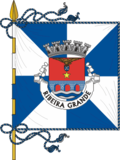Ribeira Grande (Azores)
| Ribeira Grande | |||
| Municipality (Concelho) | |||
|
Vista of the interior of Ribeira Grande looking southeast towards the Água de Pau mountain range
|
|||
|
|||
| Official name: Concelho da Ribeira Grande | |||
| Name origin: Portuguese for great/grand river | |||
| Country | |||
|---|---|---|---|
| Autonomous Region | |||
| Island | São Miguel | ||
| Civil Parishes | Calhetas, Conceição, Fenais da Ajuda, Lomba da Maia, Lomba de São Pedro, Maia, Matriz, Pico da Pedra, Porto Formoso, Rabo de Peixe, Ribeira Seca, Ribeirinha, Santa Bárbara, São Brás | ||
| Center | Matriz | ||
| - elevation | 36 m (118 ft) | ||
| - coordinates | 37°49′21″N 25°31′5″W / 37.82250°N 25.51806°WCoordinates: 37°49′21″N 25°31′5″W / 37.82250°N 25.51806°W | ||
| Highest point | Pico da Barrosa | ||
| - elevation | 1,019 m (3,343 ft) | ||
| - coordinates | 37°48′32″N 25°12′48″W / 37.80889°N 25.21333°W | ||
| Lowest point | Sea level | ||
| - location | Atlantic Ocean | ||
| - elevation | 0 m (0 ft) | ||
| Area | 180.15 km2 (70 sq mi) | ||
| - water | 1.66 km2 (1 sq mi) | ||
| - urban | 8.5 km2 (3 sq mi) | ||
| Population | 32,112 (2011) | ||
| Density | 178/km2 (461/sq mi) | ||
| Settlement | c. 1507 | ||
| LAU | Câmara Municipal | ||
| - location | Largo Conselheiro Artur Hintze Ribeiro, Matriz | ||
| - elevation | 21 m (69 ft) | ||
| - coordinates | 37°49′22″N 25°31′14″W / 37.82278°N 25.52056°W | ||
| President | Alexandre Gaudêncio (PSD) | ||
| Timezone | Azores (UTC-1) | ||
| - summer (DST) | Azores (UTC0) | ||
| Postal Zone | 9600-509 | ||
| Area Code & Prefix | (+351) 292 XXX-XXXX | ||
| Demonym | Ribeira-grandense | ||
| Patron Saint | Nossa Senhora da Estrela | ||
| Municipal Holidays | 29 June | ||
|
Location of the municipality of Ribeira Grande in the archipelago of the Azores
|
|||
| Statistics: Instituto Nacional de Estatística | |||
| Website: http://www.cm-ribeiragrande.pt | |||
| Geographic detail from CAOP (2010) produced by Instituto Geográfico Português (IGP) | |||
Ribeira Grande (Portuguese pronunciation: [ʁiˈβɐjɾɐ ˈɣɾɐ̃d(ɨ)]) is a municipality in the northern part of the island of São Miguel in the Portuguese Azores. The population in 2011 was 32,112, in an area of 180.15 km². The municipal seat is located in the civil parish of Matriz, with a population of about 4000 inhabitants, part of the urbanized core of what is commonly referred to as the city of Ribeira Grande (six civil parishes, about 10000 inhabitants).
The first settlers arrived on the island by the end of the second quarter of the 15th century. The expansion of settlement occurred after initiatives by the island's third donatary captain, Rui Gonçalves da Câmara (son of João Gonçalves Zarco, resulting in northern colonies from peoples from Madeira. Although the early settlement of Ribeira Grande is mired in murkiness owing to the lack of resources, the best sources indicate that settlement began in the late-15th or early-16th centuries. The first settlers to this region are to the northern part of the island by the end of the 15th century. On arriving, these colonists established their settlement along the ravine, which they eventually named after the river course: Ribeira Grande. What is certain is that before 1507, in the urban areas of today's Ribeira Grande, there were already colonists of a "certain social stature" living and raising cattle. One of these was Antão Rodrigues da Câmara, the bastard son Rui Gonçalves da Câmara, donatary-captain of São Miguel. His parentage was legitimized on 6 January 1499, and his property (situated in Ribeirinha) was described as an estate, with lands of woodlands, pasture and waters, with houses supported by granaries, haylofts, pastel engine, vineyards and orchards, received as part of his morgadia dated 17 April 1508.
The construction of the isolated Port of Santo Iria began at the beginning of the 16th century.
Even before being raised to the status of town (at the beginning of the 17th century), the population had already grown dramatically. This was recorded in a 1507 accord that established a master builder for the new church, assumed to be the parochial church of Nossa Senhora da Estrela. The elevation of Ponta Delgada to "town" in 1499, must have influenced the resident nobles of Ribeira Grande, who moved to have the same authority established for their burgh. Although the people involved were unfamiliar, Gaspar Frutuoso indicated that King Manuel I conceded to the locality of Ribeira Grande the privilege of town on 4 August 1507, that included a league around the centre, counted from the [central] pillory, comprising one parish (called Nossa Senhora da Purificação or Nossa Senhora da Estrela). It was Lopo Arês who brought the signed document from Lisbon, when he returned in 1508.
...
Wikipedia




